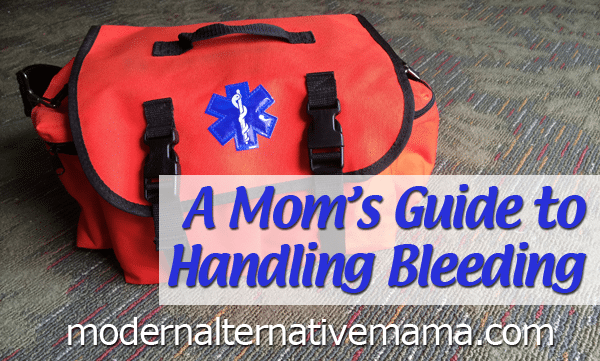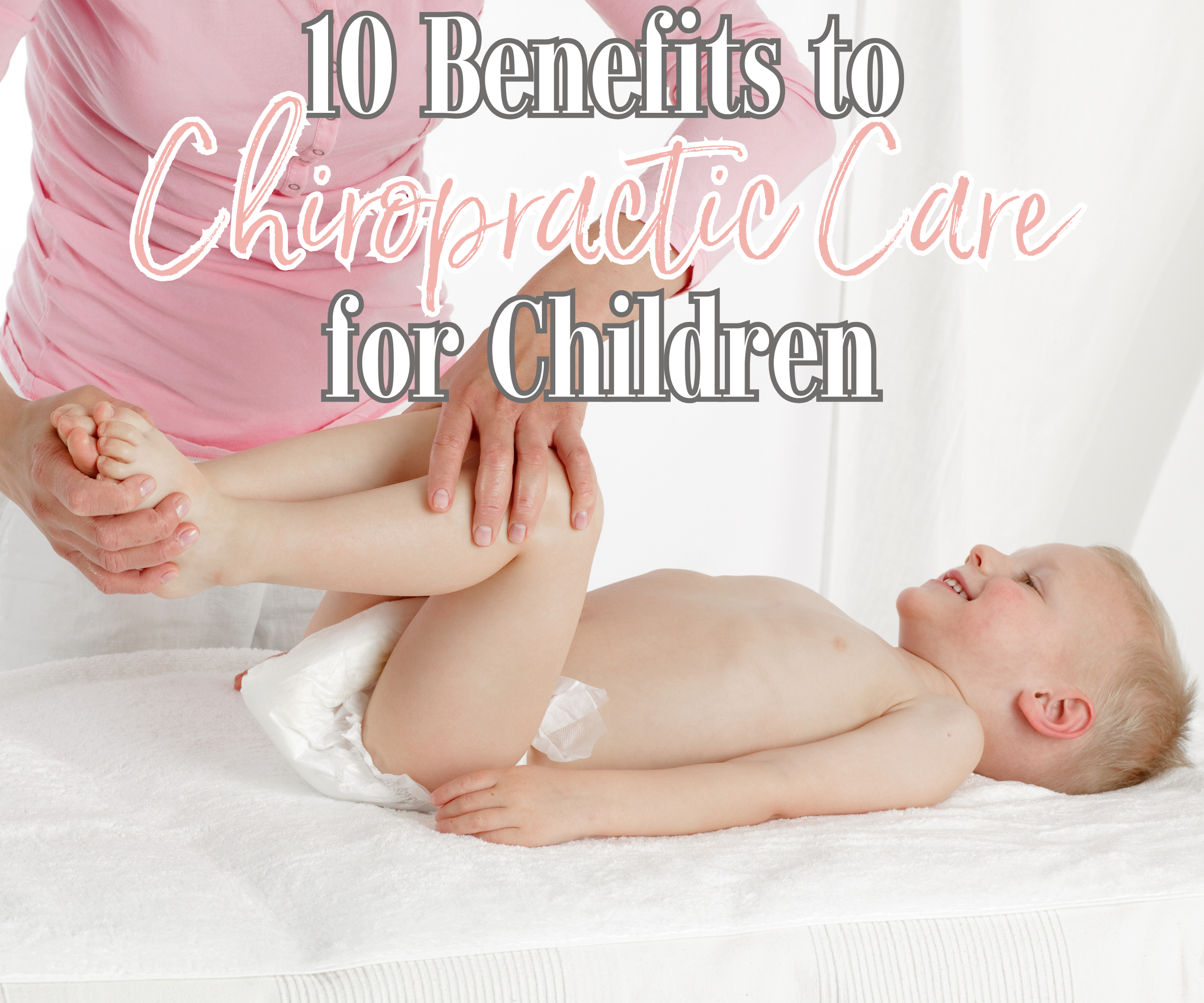By Kristen, Contributing Writer
The sight of blood still makes me feel a little woozy, even after six children, six natural births, and life on a hobby farm. Luckily a little know-how and some common sense lets even the most squeamish of moms handle external bleeding like a pro. This guide covers what you should have on hand, how to handle specific situations, and when to call the doctor.
Supplies to Have on Hand for Handling Bleeding
A well-stocked first aid kit is a mother’s friend. With it you can handle most common childhood scrapes and cuts at home quickly and efficiently.
Adhesive Bandages: You should probably buy a case of these – not only are they useful, but children wear them like badges of honor.
Gauze: Good for staunching bleeding and wrapping some wounds. Have a roll of adhesive tape, too.
Clean, old washcloths and hand towels: A larger cut may need a washcloth or hand towel – save towels with low or no pile for this use (no fluff is best). Also useful for wrapping cold packs.
Cold packs: These are useful to reduce swelling and bruising that may come in the days after an injury.
Butterfly Closures: A form of adhesive bandage that help hold a cut closed.
Cayenne Pepper (powder): Used externally this herb will stop most bleeding rapidly and helps prevent infection. A teaspoon taken in a glass of hot water is also effective. (More on cayenne here and here.)
Pure Honey / Iodine / Herbal Antibiotic Salve: Each of these has antiseptic properties that may be helpful for preventing infection in a larger cut or scrape. Minor cuts should heal well on their own. (Information on Iodine; on Honey)
Electrolyte Drinks: This can be homemade and frozen, or you can keep packets such as EmergenC on hand. Bone broths are also excellent for helping bring restoration and balance.
Food-Based Sources of Iron: After a bleed iron-rich foods are important. Liver can be made into kid-friendly pate “dips” and provides very absorbable iron. Herbal iron supplements such as Floradix are also very effective.
How to Handle Simple Cuts
As the list above indicates, the best way to care for simple cuts is to wash in clean water (if dirty), dry the area, and apply an adhesive bandage. If an object such as a splinter or piece of glass is inside the wound, attempt to remove with tweezers, then bandage as above. You may want to apply an antiseptic before bandaging.
If you’re unable to get embedded glass or another object out of the wound, or if you’re worried about a possible tetanus exposure, wrap the wound in clean gauze and call your doctor.
How to Handle Severe Cuts
Cayenne can be applied to the wound, then apply even, direct pressure with a clean pad/towel. If you have no pad to use, wrap your hand or hold your child’s hand over the bleeding (have an adult hold for him/herself). Try to raise the wounded area above the head. Have your child lie down, elevating his or her legs if possible. Once bleeding is slowed, a gauze bandage can be applied. Check periodically to ensure circulation and monitor bleeding.
Call your doctor as soon as you have the situation under control. If your child shows signs of shock, the bleeding will not stop, or an object is embedded in the skin (such as a branch, glass fragment, etc.), call 911 immediately. Do not try to remove embedded objects – drape in gauze to provide a barrier then carefully build padding on either side while you wait on emergency responders.
Head Wounds
Because of the extensive network of capillaries in the head, head wounds tend to bleed profusely even when they aren’t severe. Apply even pressure using a pad to stop bleeding, the assess the wound. If the wound is minor, a butterfly bandage may help hold it closed and stick better around hair. Wrapped gauze can help hold a pad over the wound.
Mouth and lip wounds also tend to bleed profusely even when relatively minor. Again, staunch bleeding then assess. Cold packs can be especially helpful with swelling of the lips. Call your dentist if a tooth is knocked out – putting the tooth back into its socket, in the cheek pocket, or in a glass of milk are all helpful to save the tooth. If your child is still nursing, breastfeeding can be a quick way to stop minor bleeding in the mouth.
Watch your child carefully for signs of concussion: drowsiness, confusion, dizziness, and nausea are possible signs. Call your doctor if you notice these signs – sometimes a child can be monitored at home, though many doctors prefer to have the child observed by a nurse.
If your child loses consciousness, or you notice clear fluid draining from the ears, call 911 immediately. Blood from the ears may be due to an ear infection or head injury – call your doctor immediately.
Nosebleeds
Have your child sit down with head tilted forward. If he/she can, have them pinch the soft part of the nose for about 10 minutes (breathing through the mouth). If your child is too young for this, you can do it for them. A bowl for spitting can be placed under the child’s head.
Cayenne pepper made into a tea (1 teaspoon cayenne in a cup of hot water) is very effective for nosebleeds.
Rinse the nose in warm water after 10 minutes and have your child rest (or play quietly) for several hours.
If bleeding does not stop, or continues to recur, call your child’s doctor.
Blood and Bowel Movements
If you notice blood when changing a diaper or wiping your toddler after a bowel movement, constipation and straining are the most likely cause. Track your little one’s elimination patterns and consider options to resolve constipation: probiotic supplements and foods, resistant starches (to feed the probiotic bacteria as they colonize the gut), fresh fruits, and plenty of liquids can help. Talk to your doctor if constipation persists.
If you notice dark blood in your child’s stool, this indicates internal blood. Food allergies and sensitivities are possible causes. If you notice this dark blood (often black), call your child’s doctor.
Vaginal & Postpartum Bleeding
Some teenagers experience heavy menstruation. A real-foods diet can help address this. Essential oils and herbs are other areas to explore to help your daughter regulate her cycle and lighten periods. If her periods are severe or prolonged, talk to her doctor. Iron is especially important for teens with heavy menstruation – be sure you’re including iron-rich whole foods even if you choose to work with a doctor or specialist on cycle issues.
If you experience a miscarriage monitor blood loss carefully. Early miscarriage and blood loss can result from ectopic pregnancy – seek medical assistance if you experience bleeding and severe pain. If blood loss is severe at any point in pregnancy or during loss, call 911.
Heavy bleeding in the immediate postpartum can be avoided by resting and enjoying uninterrupted time with your new baby. This promotes release of oxytocin, which helps the uterus firm up quickly. Breastfeeding also helps greatly, so guard this private time to get to know your baby. Prevent excessive bleeding in the early weeks postpartum by making baby care your primary responsibility – leave housework, meal preparation, etc. to others and enjoy “lying low” with your baby. Call your doctor or midwife if bleeding becomes severe, or turns bright red again after turning brown or white. Also call if you notice large clots.
Again, iron-rich foods are very important after such bleeds. Don’t be afraid to ask for help as you recover, and to request nutritious, whole foods specifically. These nutritious choices also build up a healthy blood supply during pregnancy – a bit of preventative medicine!
Shock
Shock is a possibility with heavy bleeding, and may get worse if your child gets panicky. If you see signs of shock, call 911 immediately, then support and comfort your child. Signs to watch for are:
- Rapid pulse
- Sweating
- Pale, clammy skin (may feel cold to the touch)
- Shallow breathing
Again, call 911 immediately if you see these signs or anything more severe (such as loss of consciousness). Then address the cause of shock – stop the bleeding using the steps outlined above.
Settle your child lying down, and elevate his or her legs. You should also loosen or remove an constricting clothing. Cover him or her with blankets for warmth until help arrives. Comfort your child as you wait – his or her panic could intensify shock symptoms.
Stay Calm and Confident
Anything more than a minor “boo boo” can make a mom queasy, and lots of blood can terrify even the most fearless among us. Staying calm is the best thing to do. Put squeamishness on hold and care for your child with solid first aid and common sense – remember that first and foremost, even pressure helps stop bleeding. Don’t hesitate to call your doctor or contact emergency responders if you’re concerned – it’s always best to listen to your instincts.
Most childhood cuts, bruises, and scrapes can be handled safely at home – and remember, a kiss and some cuddling can make even the toughest cuts all better 🙂







